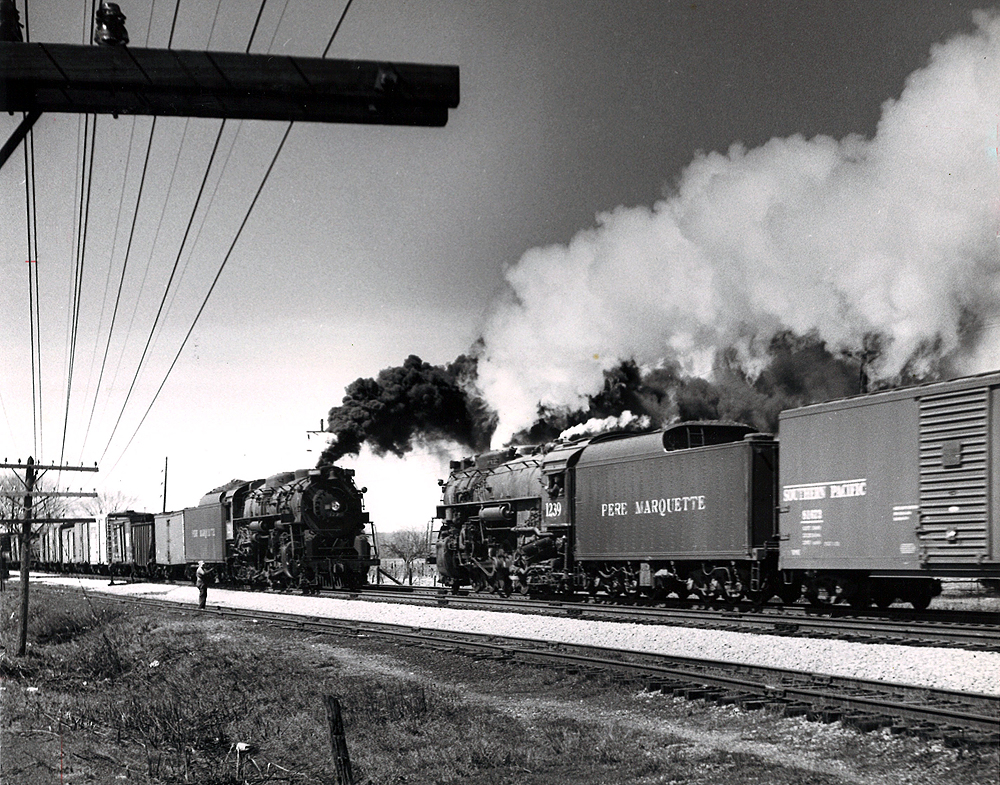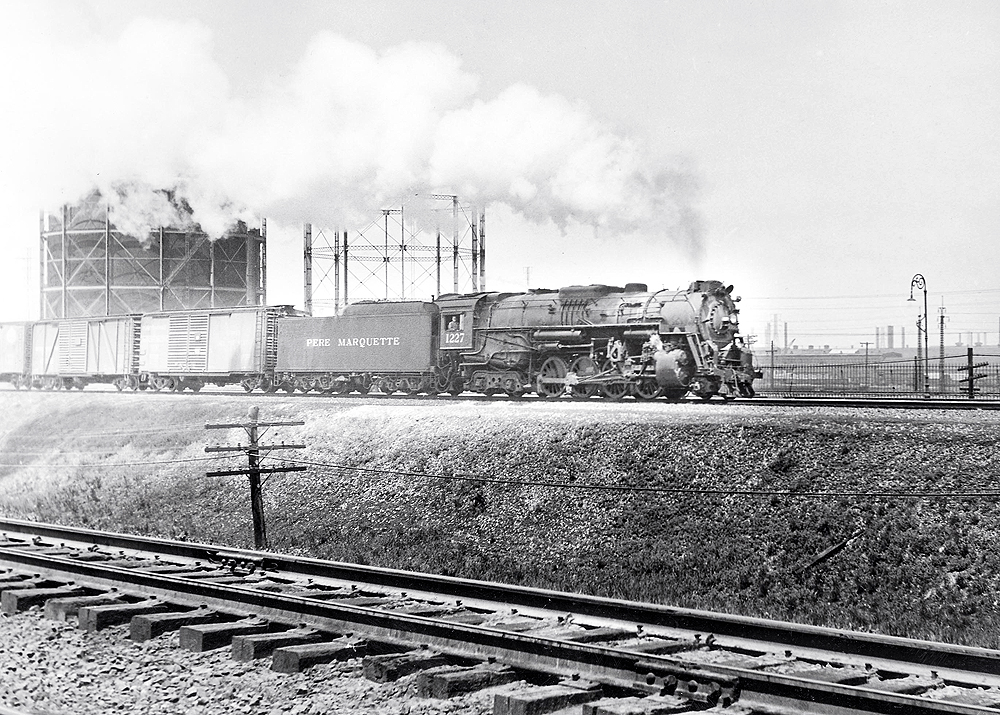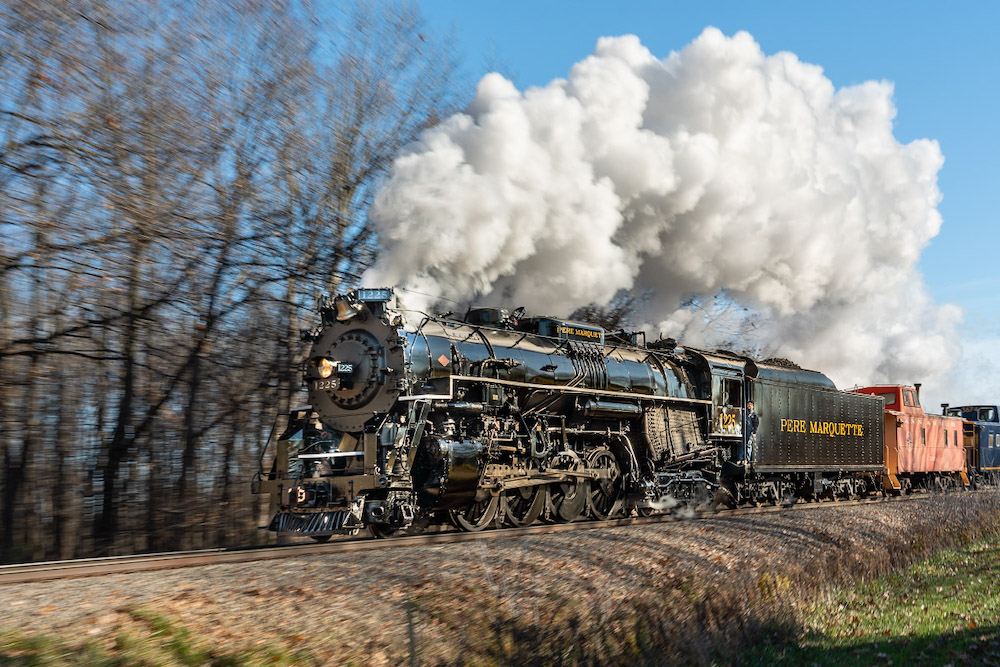
By the late 1930s, the Pere Marquette Railway had made a big splash in motive power acquisition. And rightly so, as the tired and second-rate fleet of steam locomotives was not enough to pull the Michigan railroad out of the hardship of the Great Depression. An order of 15 N-class 2-8-4s initially was rolled out by the Lima Locomotive Works in Ohio, beginning the brief yet significant era of the Pere Marquette Berkshire steam locomotives.
How the nicknamed “Poor Marquette” came in possession of the celebrated Super Power roster relates to Oris P. and Mantis J. Van Sweringen. The Cleveland brothers controlled several railroads: New York, Chicago & St. Louis Railroad, commonly known as the Nickel Plate Road; the Erie Railroad; the Chesapeake & Ohio Railway; and, of course, the Pere Marquette. Out of this conglomerate came the Advisory Mechanical Committee (AMC), established in 1929 as a mechanical dream team for the shared development and construction of locomotives for the Van Sweringens’ railroads.
By 1934, the Nickel Plate Road began boosting its freight service with a new fleet of Berkshire-type locomotives as part of the Super Power design, introduced in the 1920s by Lima and its design director, William F. Woodard. The successful combination of speed and power from what became the S class immediately caught the attention of the Pere Marquette through the AMC. This resulted in order No. 1143 for the PM, consisting of Nos. 1201-1215 of the N class, which started arriving on the railroad in September 1937. The newest members of the 2-8-4 lineage were slightly larger and heavier than the Nickel Plate predecessors, based on the 26-by-34-inch cylinders with an overall engine weight of 218 tons. As a cost-saving measure, all PM Berkshires would ride on plain bearings as opposed to roller bearings, which were rapidly becoming the new industry standard.
The locomotives’ weight kept the Berkshires off secondary and branch lines, particularly north of Saginaw, Mich. However, their 69,368 pounds of tractive effort — delivered via 69-inch drivers plus an additional trailing-truck booster — thrived on the fast-freight main lines between Chicago, Grand Rapids, Detroit, Saginaw, and Toledo. The Overnighter, a Detroit-Chicago service launched in 1939, showcased the locomotives at their best, hustling the heavy traffic at speeds that could nearly match the performance of passenger trains along the railroad.

The success of the Pere Marquette Berkshires prompted the go-ahead for an additional order of 12 locomotives. Designated as the N-1 class, Nos. 1216-1227 would see an increase in length but were otherwise identical to their older siblings. The November 1941 delivery, just days before the attack on Pearl Harbor, led to the immediate assignment of primary freight for the war effort. Throughout World War II, Detroit’s automotive industry was transformed into the “Arsenal of Democracy,” with PM doing its share bringing in raw materials and shipping out finished products of military vehicles.
Relief for both the Super Power fleet and railroad arrived in early 1944 with the final order of 2-8-4s. The 12 N-2 class locomotives, Nos. 1228-1239, came with significant modifications including an all-cast steel frame, heavier weight, and the steam dome positioned behind the sandbox. Keeping the 39-total Berkshires in service was the job of the railroad’s locomotive facility at the Wyoming Yard in Grand Rapids. The thousands of running miles paid off with the war’s end in August 1945, but the honeymoon for these machines wouldn’t last much longer.
Postwar changes for both the Pere Marquette and the Berkshires were swift. The takeover from the Chesapeake & Ohio on June 6, 1947, ramped up dieselizing the roster. A handful of the PM 2-8-4s were transferred in 1951 to Ohio, Kentucky, and Virginia for coal traffic on the C&O, but eventually removed from service in 1953. Those left behind in Michigan saw earlier retirement in 1951, shortly after being demoted to helper service out of Holland, Mich. The lifespan for most of these locomotives was brief: all but two were sold for scrap by 1961.
N-1 class No. 1223 was part of the lineup of stored Berkshires in New Buffalo, Mich., before being pulled out for cosmetic restoration. Its new destination was the Michigan State Fair in Detroit as a donated display piece. Since 1981, it has continued to be displayed at Chinook Pier Park in Grand Haven, Mich.
The other survivor, No. 1225 of the N-1 class, was also saved from the New Buffalo scrap line for display in 1957 at Michigan State University in East Lansing, Mich. A 1969-1988 restoration to operation that involved relocating to Owosso, Mich., has today made this stand-out an excursion veteran, the centerpiece of the Steam Railroading Institute, and a star for the animated 2004 holiday film The Polar Express.















Retired, but not scrapped by 1961. Several remained in storage at New Buffalo until the late 1960s. The rumor was that they were kept until their trusts expired.